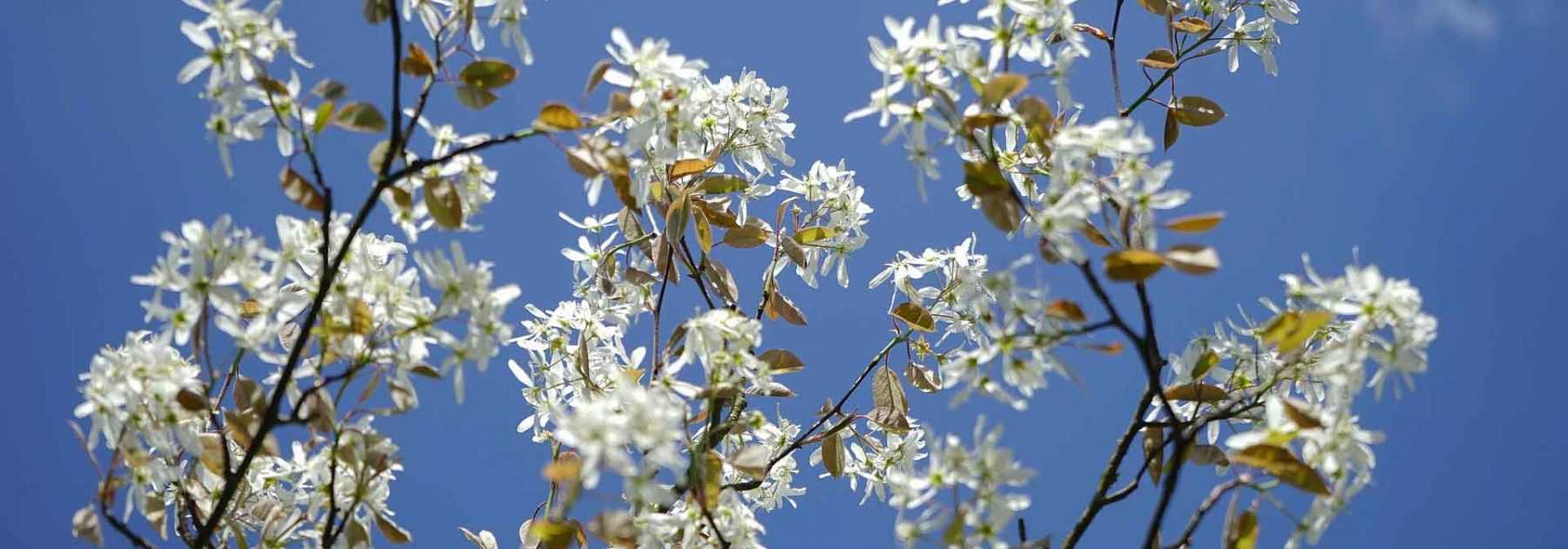
Serviceberry: Planting, Pruning, Growing
Contents
The Serviceberry in a Few Words
- Its spring flowering is abundant and spectacular
- Its silhouette is slender and elegant
- Its fruits are both edible and decorative
- Its spicy-coloured foliage sets the garden ablaze in autumn
- Hardy down to -25°C, it’s easy to grow as a hedge, in borders or as a standalone specimen
Our expert's word
The Serviceberry is a spring-flowering shrub that heralds the arrival of fine weather and gently announces the end of winter. In the garden, it is among the first to bloom. Still too little known, whether it’s the Amelanchier lamarckii, the A. canadensis or Canadian Serviceberry, the ‘Ballerina’ Serviceberry or the Amelanchier laevis, all deserve to be more widely cultivated for their outstanding ornamental qualities from spring to autumn as well as for their edible and decorative fruiting.
The deciduous foliage of this shrub is also highly decorative. Green or bronze when young, it takes on a flamboyant autumn colour: its leaves turn red or coppery, setting the garden ablaze during the Indian summer.
Very hardy, down to -25°C when sheltered from drying winds, undemanding, the Serviceberry is easy to grow in full sun or partial shade in any cool, well-drained soil.
Its compact yet elegant shape, abundant flowering and relatively slow growth make it an ideal choice for small spaces as well as for natural gardens where it creates lovely focal points.
It is perfect for creating beautiful informal, country or fruiting hedges, or as a standalone specimen at the centre of a romantic composition against a backdrop of evergreen foliage.
We offer a wide range of Serviceberry varieties for purchase, to plant in beds, hedges or as standalone specimens. Discover everything you need to know about Serviceberries!
Botany
Botanical data
- Latin name Amelanchier
- Family Rosaceae
- Common name Juneberry, Serviceberry
- Flowering April to June
- Height 2 to 12 m
- Exposure sun or partial shade
- Soil type All types
- Hardiness -25° to -30°C
Native to North America, particularly Canada, as well as Eastern Europe and Asia, the Juneberry grows naturally in various habitats depending on the species – from damp woodlands for American varieties to rocky, dry terrain for Amelanchier lamarckii. It belongs to the diverse Rosaceae family, alongside Prunus, roses and strawberries.
The genus includes around 25 species of deciduous trees and shrubs, with about ten cultivated in France including some interesting cultivars. Alongside the common Juneberry (A. ovalis), the most frequently encountered in our gardens is Amelanchier lamarckii or Lamarck’s Serviceberry. Other notable varieties include the spreading, bushy Amelanchier laevis which prefers moist soils, the tall and dense Canadian Serviceberry (A. canadensis), the narrow, graphic Amelanchier alnifolia ‘Obelisk’, and the prolific hybrid A. laevis ‘Ballerina’ with its compact form.
We must also mention Amelanchier × grandiflora and its cultivar ‘Robin Hill’, compact and upright with white flowers tinged pink in bud.
Juneberries have relatively slow growth, forming either small trees or large shrubs with star-shaped, usually white flowers. They’re distinguished mainly by their shape and size. While typically reaching 3-8m at maturity, some varieties can grow to 12m tall, albeit slowly. Their form varies from upright to spreading, sometimes developing into beautifully dense shrubs.
Most Juneberries naturally form multi-stemmed clumps, creating compact silhouettes with several trunks. In A. lamarckii, the upright stems are covered in springtime white down.
This shrub propagates naturally through layering, with creeping branches eventually forming new plants.
Bright, generous and early, the spring flowering of Juneberry is spectacular: in the garden, it’s one of the first shrubs to bloom in late winter when most plants are just awakening. A herald of spring, its delicate, snowflake-like blossoms signal the return of milder weather.
From April to May, Juneberries become covered in small star-shaped flowers, pure white or tinged pink, gathered in abundant hanging clusters 3-15cm long on more or less arched branches. Amelanchier spicata produces upright spikes of white flowers. These nectar-rich blooms sometimes exude a subtle vanilla fragrance. You can create spring bouquets with flowering branches when buds are just opening – they last well in vases.
This dense, delicate flowering precedes the foliage, with first blossoms appearing just before leaves emerge.
By early summer, these 1-2cm white or pink stars with five distinct petals give way to small edible round fruits called juneberries, resembling blueberries the size of large peas (7-10mm diameter). These sweet, fleshy berries start red, turning dark purple or bluish-black when ripe, with juicy, lighter flesh containing small seeds. Harvest in summer when fully black, from July to August, before they fall.
While beloved by birds, they’re delicious eaten fresh or cooked in jams and pies. Still little-known in France, they’re widely consumed as sauces or compotes in Eastern Europe and Canada to accompany roasted meats. Some varieties like A. canadensis, A. lamarckii and A. laevis are specifically cultivated for these raspberry or grape-flavoured fruits.
The deciduous foliage is another asset, displaying magnificent colours from spring through autumn. Leaves appear after flowering, emerging bronze-pink in spring, turning yellow-green or medium green in summer, then transforming with the first chills into cinnamon-orange, coppery red or intense purple before falling.
The oval, elliptical or lance-shaped leaves (sometimes finely toothed in A. ovalis) measure 2-8cm long. Some varieties have downy white undersides in spring (lost over time), while others like ‘Ballerina’ develop a glossy sheen.
When grown in suitable conditions, Juneberry is easy to cultivate – generous, resilient and undemanding. For best flowering, plant in full (but not scorching) sun, though it adapts to partial shade.
While this shrub withstands severe cold (even benefiting from cold winters for better flowering), it dislikes drying winds and overly dry summer soils. Extremely hardy, it survives temperatures as low as -25°C (sometimes -30°C), ensuring longevity in all regions. However, Mediterranean climates may be too hot and dry in summer.
While some American varieties like A. laevis prefer acidic soils, others such as Amelanchier canadensis tolerate wet or even chalky, stony ground like Lamarck’s Serviceberry. Most adapt well to any decent garden soil provided it’s moist but well-drained.
Its compact yet elegant shape and slow growth make Juneberry more versatile than it appears, suitable for all natural gardens including small spaces as attractive focal points. The relatively slow development allows some species (Amelanchier laevis or A. canadensis) to be grown in large containers while young, bringing spring blossoms and stunning autumn colours to patios or entrances.
It works equally well as a standalone specimen in borders or clearings, in groups with other shrubs, or in wild or fruiting hedges. As an acid-loving plant, it combines beautifully in borders with early-flowering ericaceous plants like Camellias, Azaleas, Rhododendrons, Sarcococca or Daphne.
It creates stunning effects alongside flowering shrubs with decorative foliage, either harmonising or contrasting beautifully with Magnolias, Forsythia, Flowering Currant, Spirea, Viburnum, Mock Orange, Japanese Quince, Prunus…
Species and main varieties
Among the varieties mainly cultivated in our gardens there are about ten species or cultivars: three originating from North America (A. laevis with a spreading and bushy habit, A. canadensis, very common with a dense and upright habit, and A. stolonifera), one of Asian origin (A. asiatica) and two from Europe (A. confusa and A. lamarckii, the most common in our gardens, the latter often being confused with Amelanchier canadensis or laevis).
We also distinguish Amelanchier ‘Ballerina’, a more compact variety (5 x 3 m) with larger inflorescences, and the species Amelanchier spicata, which is covered in white spike-like flowers.
The Amelanchier alnifolia ‘Obelisk’ differs with a narrower habit. The horticultural Amelanchier x grandiflora, sometimes shrubby in habit, and its cultivar ‘Robin Hill’, compact and upright with white flowers tinged pink in bud, are also interesting.
All are very hardy, flower in spring, and bear highly decorative foliage. They mainly differ in their habit, spreading or upright, and their size, averaging 3 to 8 m in height at maturity: A. spicata will not exceed 3 m in height when mature, while A. lamarckii can reach 10 m in height with a spread of 12 m.
The Most Popular
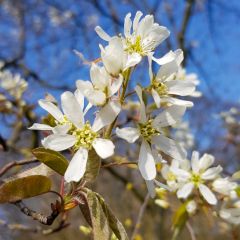
Amelanchier lamarckii
- Blütezeit May, June
- Höhe bei Reife 7 m
Our Favourite
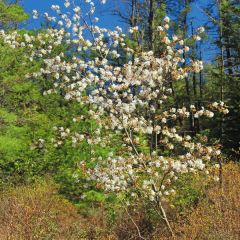
Amelanchier spicata
- Blütezeit May, June
- Höhe bei Reife 3 m
Planting
Where to Plant the Serviceberry
It thrives throughout France, except perhaps in Mediterranean climates, which can be too hot and dry in summer. The Serviceberry dislikes overly dry soils in summer. Highly hardy, it can withstand very low temperatures of -25°C to -30°C, ensuring excellent resilience in all regions.
However, avoid exposing it to drying winds, which may scorch its foliage and damage its flowers. Plant it in a sheltered spot in full sun (if not too intense) or partial shade, preferably in a rather humid environment, though it tolerates dry shade reasonably well.
It thrives in any good, fresh, well-drained garden soil, even clayey or moist, preferably non-calcareous and slightly acidic.
It makes beautiful, free-growing fruiting hedges or charming focal points in borders, standing out against a backdrop of evergreen foliage (Forsythia, Cherry Laurel, Viburnum) and adding an original touch. It pairs well with ericaceous plants like Camellias, Azaleas, and Rhododendrons.
When to Plant?
Serviceberries can be planted in spring (February to April) or preferably in autumn (September to November) to encourage root establishment before winter and enjoy flowering in the first year. Bare-root or potted specimens can be planted from October to March, avoiding frost or extreme heat.
How to Plant the Serviceberry?
The Serviceberry adapts well to ordinary garden soil.
Depending on the variety and use, space plants 2–3m apart in informal hedges, or 4–5m apart for standalone specimens. They can also be planted in groups of 3 or 5 in spring for a enchanting display.
Stake if needed. Mulch in spring with a thick layer of bark or pine needles to retain soil moisture. Water generously for the first few weeks to aid establishment, then twice weekly during heatwaves, especially in drought-prone soils.
Maintenance, Pruning and Care
The Serviceberry is an easy-care shrub. These species often produce suckers; in early spring, regularly remove the suckers if you wish to maintain a beautiful shape and a single trunk for your shrub – they naturally tend to form multiple trunks (a clump).
Pruning is neither essential nor necessary, except to balance the branching or remove crossing branches after flowering.
Depending on your soil type, monitor your shrub’s water needs during dry spells, especially in the first few years. It’s best to mulch the base annually in May.
→ Read also: How to Prune a Serviceberry?
Pests and potential diseases
The Serviceberry is generally resistant to most diseases as well as insect or pest attacks. However, in some regions, it may fall victim to fire blight, a devastating disease that particularly affects the Rosaceae family and can kill the shrub within weeks. The bacteria spread rapidly in warm, humid weather, between 25 and 30°C. Leaves then develop rust-coloured spots, flower buds wither and turn brown, and branches curl and dry out—the shrub appears scorched by fire.
There is no cure, so prevention is key to stopping attacks and contamination. Prune 20 to 30 cm below infected areas, burn all affected parts, and spray preventatively in spring (March-April) with a copper-based solution (used sparingly) or, preferably, Bordeaux mixture or horsetail decoction.
In mild, damp conditions, the shrub may develop powdery mildew: spray with a sulphur-based fungicide, nettle manure, or horsetail decoction.
→ Learn more about Serviceberry diseases and pests in our advice guide!
Propagation
While it’s possible to propagate Amelanchier by seed, we recommend cuttings, air layering, or division of suckers instead – all simpler methods that yield good results.
By cuttings
Amelanchier can be propagated from softwood or semi-hardwood cuttings (stems transitioning from soft to hard wood) in August-September using the closed-case method. After flowering, take 10-20 cm cuttings.
Plant them in a light, well-draining substrate kept moist. Pot them up once roots have formed. Overwinter them frost-free. Transplant into open ground the following autumn.
By layering
Root development in layers is rather slow – patience is required!
- In late summer, bend a branch down to ground level where it naturally touches the soil
- Remove leaves and side shoots from this section of stem
- Scrape the bark over a 5-10 cm section with a small knife
- Dig a shallow trench near the parent plant
- Lay the branch in it and bury part for rooting
- Backfill the trench and secure the layer with two metal pegs
- Support the upright tip with a stake
- The following spring, separate the new plant once sufficiently rooted and transplant
By division of suckers
As Amelanchier often produces suckers (new shoots around the base), this propagation method is very straightforward. Between late November and early March, detach the numerous suckers that have developed. Use a spade to cut the root closest to the parent plant. Transplant these young plants directly into well-drained, compost-enriched soil.
→ Learn more in our guide How to take Amelanchier cuttings.
Pair with
The Serviceberry offers two seasons of interest: in spring when it’s covered with white flowers and bronze foliage, and in autumn when its leaves turn to fiery red and copper hues.
To fully appreciate its beauty, plant it as you wish – in a mixed hedge, as a standalone specimen, or in a border combined with other shrubs and bulbs against a backdrop of evergreen conifers or shrubs that will highlight the delicate beauty of its spring flowers and its flamboyant autumn foliage.
This graceful shrub, essential in spring displays, finds its place in natural gardens, amidst a sunny clearing, surrounded by spring bulbs such as daffodils, squills, hyacinths, and botanical tulips.
Japanese flowering cherries, ornamental crabapples, flowering currants or Japanese quince make excellent companions, as do magnolias, white lilacs, mock oranges, early-flowering roses, flowering dogwoods, and deciduous azaleas which will complement its bloom with their delicate hues. It can be paired with spring-flowering shrubs like Forsythia. Some specimens can support a soft pink clematis or purple vine.
It’s also perfect in an ericaceous bed, alongside evergreen shrubs or early-flowering varieties; Camellias, deciduous Azaleas, Rhododendrons, Sarcococca, Japanese Andromeda or Daphnes.
In autumn, its copper or purple blazing leaves will beautifully contrast with the bright orange berries of Cotoneaster or other ornamental fruiting trees (link) like Kashmir Rowan.
Alongside flowering shrubs with decorative foliage, it will create either harmonious tones or striking contrasts; Spireas, Viburnums, Bloodtwig Dogwood, Spindle…
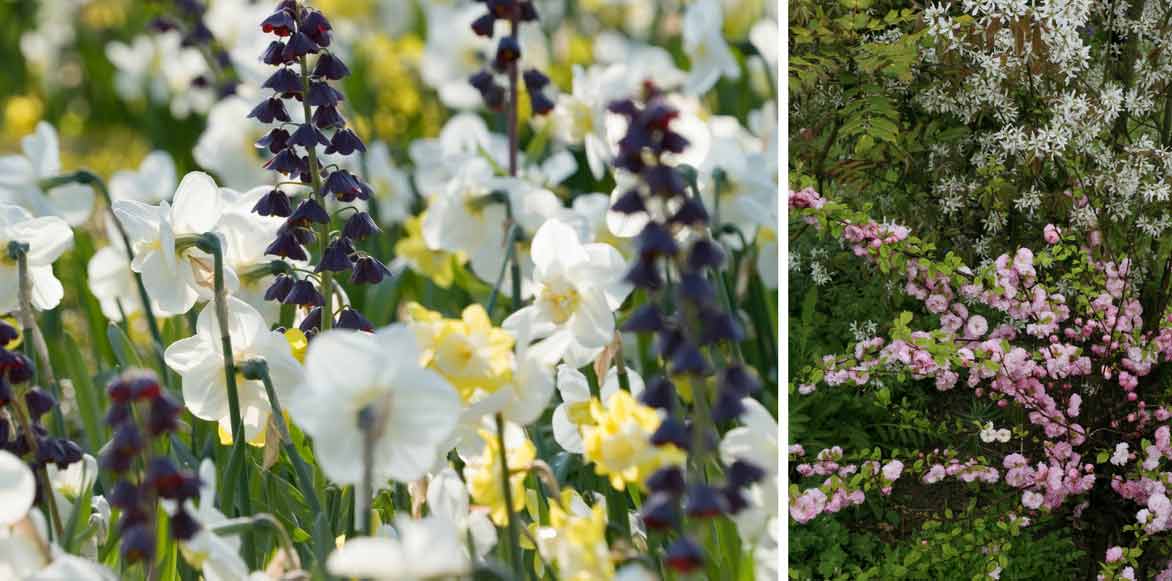

Amelanchier lamarckii -Fritillaria persica-daffodil-Prunus -Photo Credit GAP: Graham Strong -Pernilla-Bergdahl
→ Discover more companion planting ideas for Serviceberry
Useful resources
Discover our wide range of Hedge Shrubs: ideal varieties to complement the Serviceberry.
Learn how to harvest and preserve Serviceberry fruits
Explore our advice sheet on plant pairing ideas with Serviceberry
Discover our tips for growing a Serviceberry in a pot
Find your article: Choosing a Serviceberry
Frequently asked questions
-
Are the leaves of my Serviceberry turning white, is this normal?
No, your shrub is most likely affected by powdery mildew. If some leaves and twigs show a fluffy, white coating, you can limit the spread by removing and burning the infected leaves. Then spray with nettle manure or horsetail decoction as a treatment, but also as a preventive measure.
-
How to consume Serviceberry fruits?
The fruits of the serviceberry or juneberries can be eaten like blueberries, which they resemble: they can be consumed raw, but are more flavourful when cooked. You can use them to make jams, compotes, creams, incorporate them into pies or clafoutis, and even as a sauce to accompany meats. These delicious berries can also be dried or frozen.
- Subscribe!
- Contents


































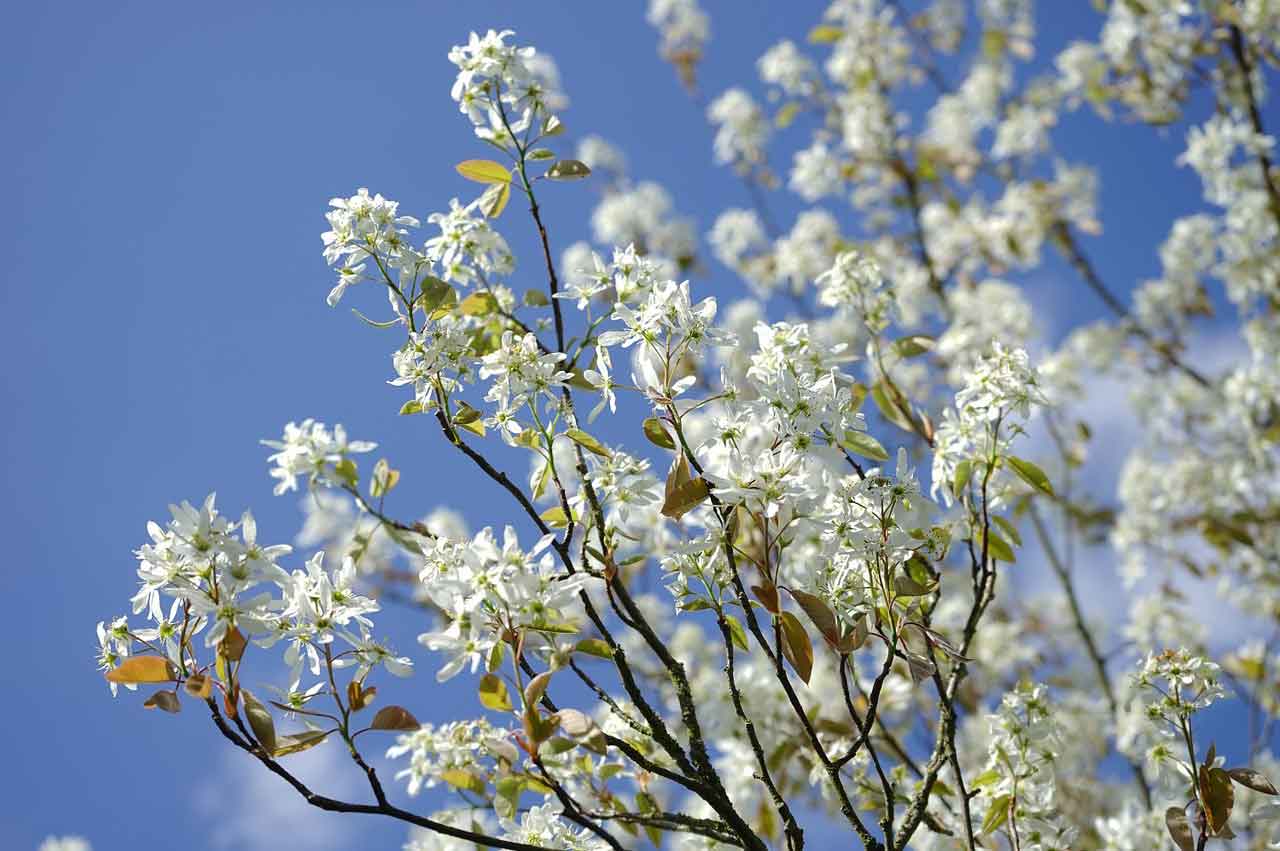

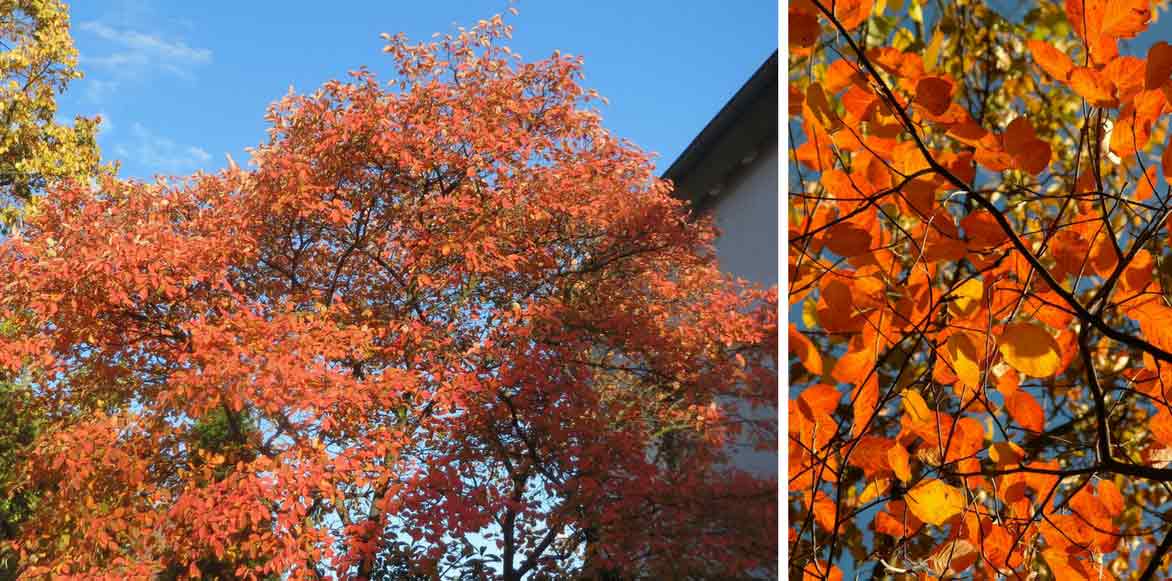
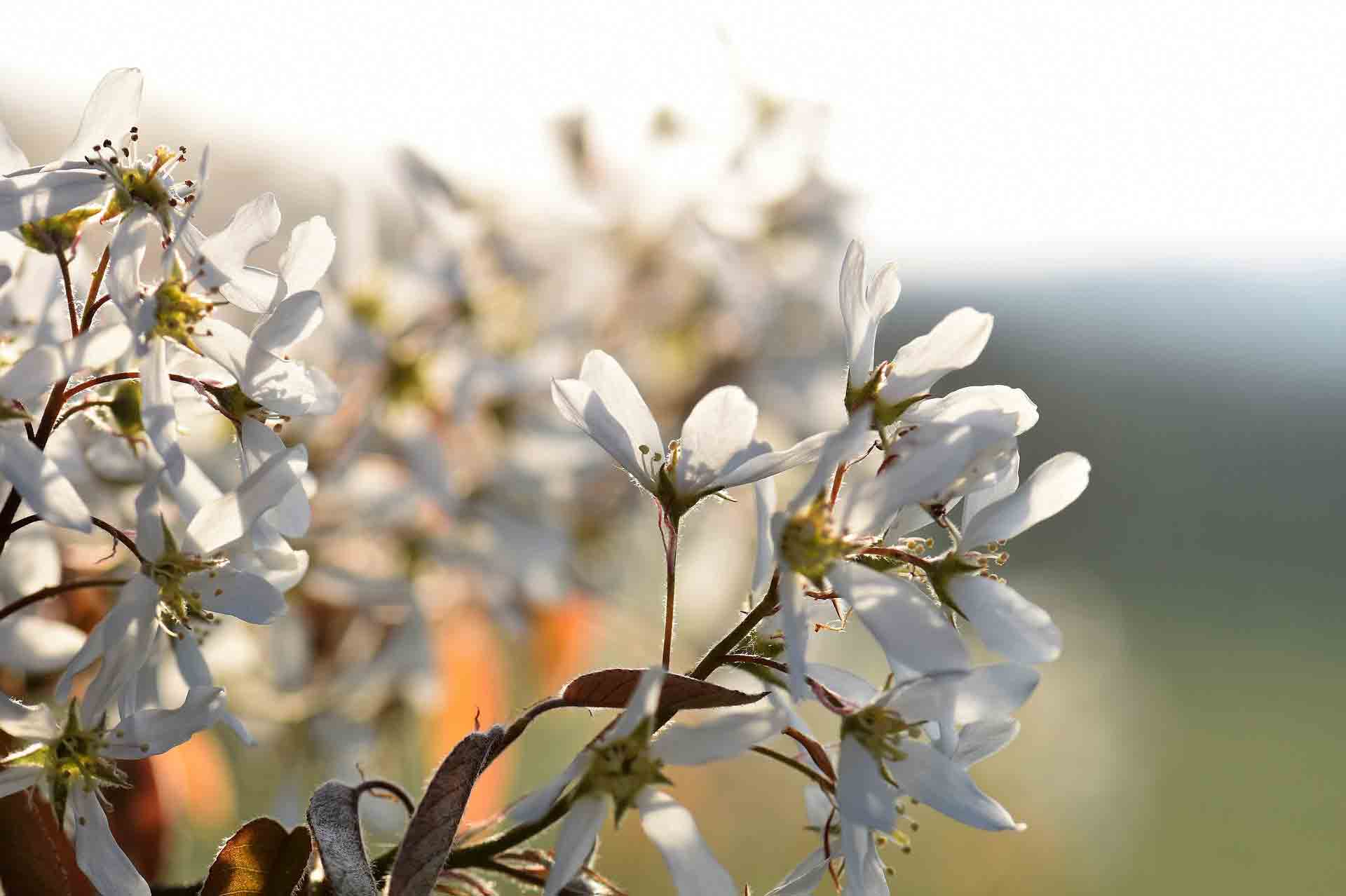

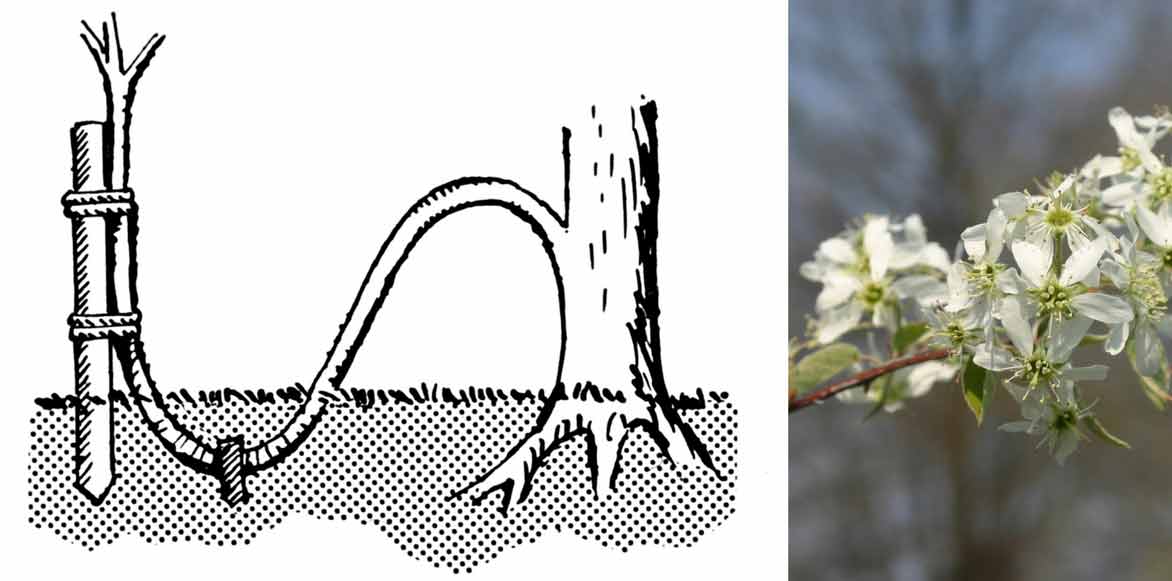
Comments